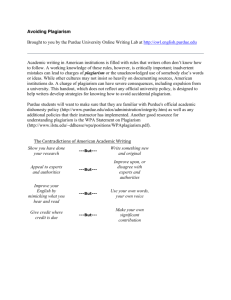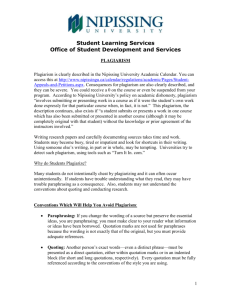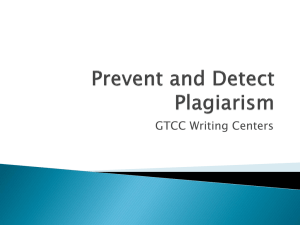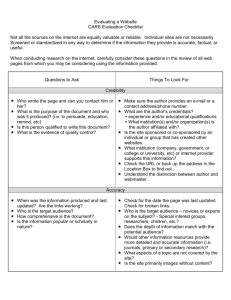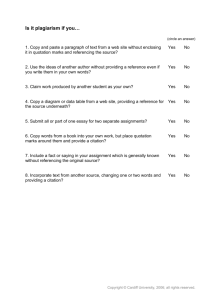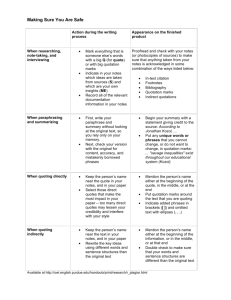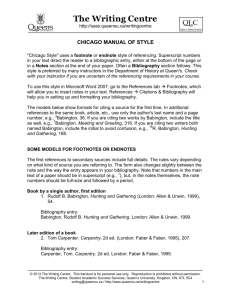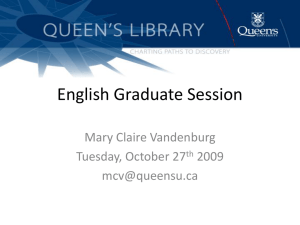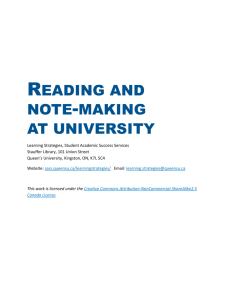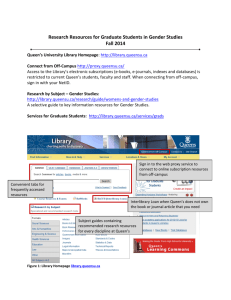Avoiding Plagiarism - Student Academic Success Services
advertisement
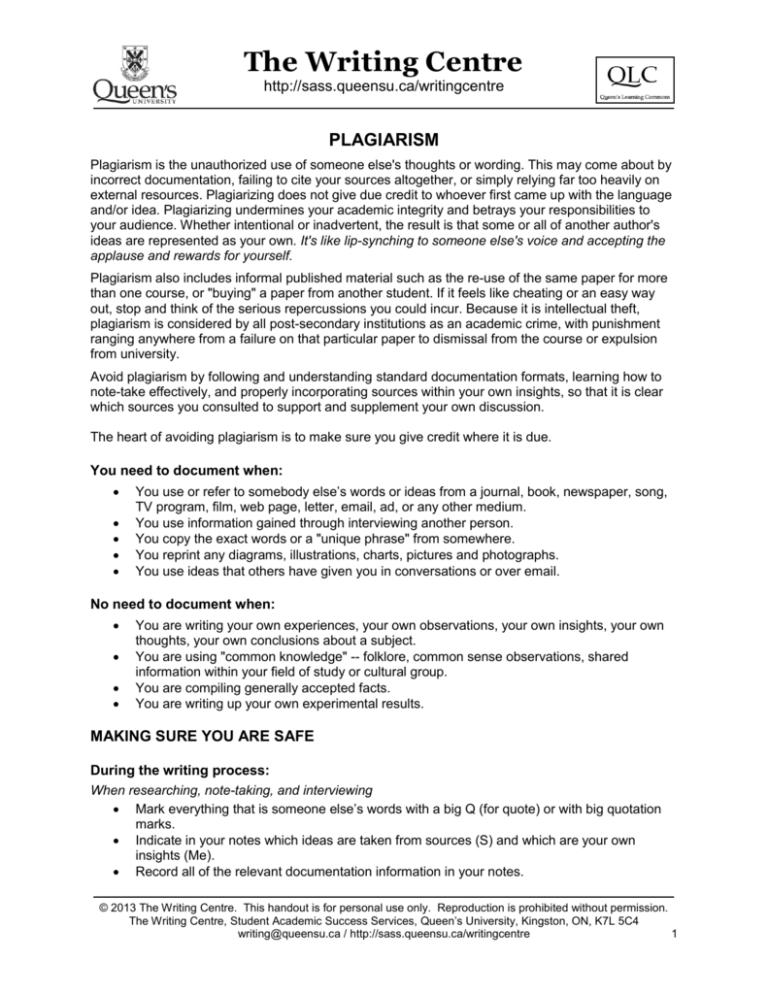
The Writing Centre http://sass.queensu.ca/writingcentre PLAGIARISM Plagiarism is the unauthorized use of someone else's thoughts or wording. This may come about by incorrect documentation, failing to cite your sources altogether, or simply relying far too heavily on external resources. Plagiarizing does not give due credit to whoever first came up with the language and/or idea. Plagiarizing undermines your academic integrity and betrays your responsibilities to your audience. Whether intentional or inadvertent, the result is that some or all of another author's ideas are represented as your own. It's like lip-synching to someone else's voice and accepting the applause and rewards for yourself. Plagiarism also includes informal published material such as the re-use of the same paper for more than one course, or "buying" a paper from another student. If it feels like cheating or an easy way out, stop and think of the serious repercussions you could incur. Because it is intellectual theft, plagiarism is considered by all post-secondary institutions as an academic crime, with punishment ranging anywhere from a failure on that particular paper to dismissal from the course or expulsion from university. Avoid plagiarism by following and understanding standard documentation formats, learning how to note-take effectively, and properly incorporating sources within your own insights, so that it is clear which sources you consulted to support and supplement your own discussion. The heart of avoiding plagiarism is to make sure you give credit where it is due. You need to document when: You use or refer to somebody else’s words or ideas from a journal, book, newspaper, song, TV program, film, web page, letter, email, ad, or any other medium. You use information gained through interviewing another person. You copy the exact words or a "unique phrase" from somewhere. You reprint any diagrams, illustrations, charts, pictures and photographs. You use ideas that others have given you in conversations or over email. No need to document when: You are writing your own experiences, your own observations, your own insights, your own thoughts, your own conclusions about a subject. You are using "common knowledge" -- folklore, common sense observations, shared information within your field of study or cultural group. You are compiling generally accepted facts. You are writing up your own experimental results. MAKING SURE YOU ARE SAFE During the writing process: When researching, note-taking, and interviewing Mark everything that is someone else’s words with a big Q (for quote) or with big quotation marks. Indicate in your notes which ideas are taken from sources (S) and which are your own insights (Me). Record all of the relevant documentation information in your notes. © 2013 The Writing Centre. This handout is for personal use only. Reproduction is prohibited without permission. The Writing Centre, Student Academic Success Services, Queen’s University, Kingston, ON, K7L 5C4 writing@queensu.ca / http://sass.queensu.ca/writingcentre 1 The Writing Centre http://sass.queensu.ca/writingcentre When paraphrasing and summarizing Write your paraphrase or summary without looking at the original text, so you rely only on your memory. Next, check your version with the original for content, accuracy, and mistakenly borrowed phrases. When quoting directly Keep the person’s name near the quote in your notes, and in your paper. Select only quotes that make the most impact in your paper -- too many direct quotes may lessen your credibility and interfere with your style. When quoting indirectly Keep the person’s name near the text in your notes, and in your paper. Rewrite the key ideas using different words and sentence structures from the original. In the finished paper: Check against your notes (or photocopies of sources) to make sure that anything you've used is acknowledged using some combination of: in-text citation, footnotes, bibliography, quotation marks When paraphrasing and summarizing Begin your summary with a phrase crediting the source: e.g., According to Jonathan Kozol... Put any words or phrases that you can't or don't want to change in quotation marks: e.g., "Savage inequalities" exist throughout our educational system (Kozol). When quoting directly Mention the person’s name at the beginning of the quote, the middle, or the end. Put quotation marks around the text that you are quoting. Indicate added phrases in brackets ([ ]) and omitted text with ellipses (. . .). When quoting indirectly Mention the person’s name at the beginning of the information, or the middle or end. Double-check to be sure your words and sentence structures are different from the original text. Material is probably "common knowledge" if . . . You find the same information undocumented in several other sources. You think it is information that your readers will already know. Anyone could easily find the information with general reference sources. For further tips on avoiding plagiarism, visit these first-class sites, which answer frequently asked student questions about the process of citing sources: www.utoronto.ca/writing/plagsep.html web.uvic.ca/wguide/Pages/CitPlagiarism.html THIS HANDOUT WAS CRIBBED FROM THE PURDUE UNIVERSITY ONLINE WRITING LAB http://owl.english.purdue.edu © 2013 The Writing Centre. This handout is for personal use only. Reproduction is prohibited without permission. The Writing Centre, Student Academic Success Services, Queen’s University, Kingston, ON, K7L 5C4 writing@queensu.ca / http://sass.queensu.ca/writingcentre 2
